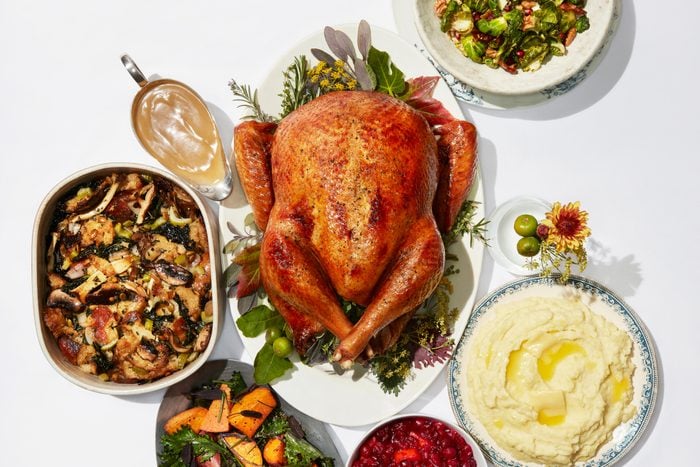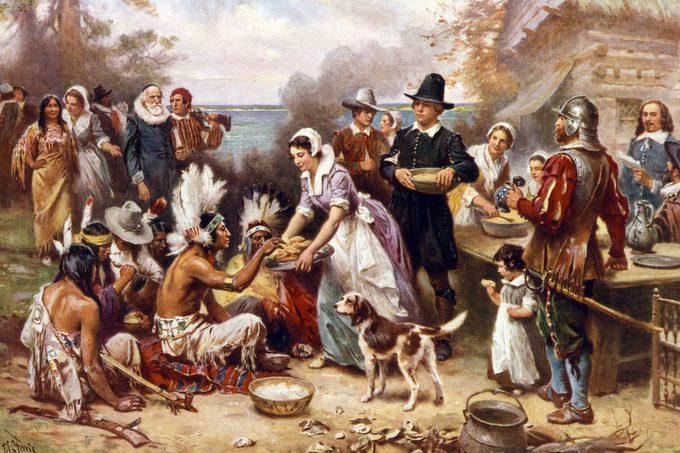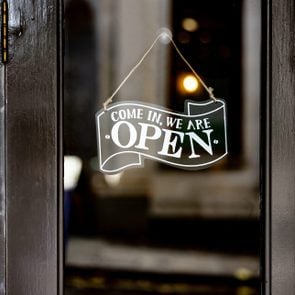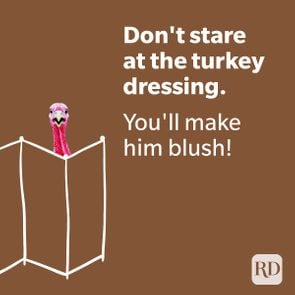Why Do We Eat Turkey on Thanksgiving, Anyway?
Updated: Dec. 02, 2023

Discover how the all-American combination of turkey and Thanksgiving first came to be
There are few things as quintessentially American as eating turkey on Thanksgiving. But every tradition has to start somewhere—even the day we celebrate Thanksgiving has an origin story. So why do we eat turkey on Thanksgiving?
If it’s your Thanksgiving wish to learn, you’re about to find out. We spoke to food historians to discover exactly when we started eating turkey on Thanksgiving and why it has endured as a Thanksgiving tradition. Plus, we got some information on the latest turkey trends. Read on to find out!
Get Reader’s Digest’s Read Up newsletter for more holidays, humor, cleaning, travel, tech and fun facts all week long.
The history of Thanksgiving
The history of Thanksgiving is a bit less straightforward than the story most of us learned in grade school. “It is really, really hard to say when the first ‘Thanksgiving’ was,” says Emelyn Rude, founder and editor-in-chief of the food history magazine Eaten. “Through the creation of the mythology around the holiday, many people emphasize the recorded dinner in 1621 in Plymouth, Massachusetts, as the first instance of a Thanksgiving, but this was just another version of a very common harvest festival that many cultures celebrated throughout American history. In all likelihood, similar celebrations happened frequently before 1621.”
As far as that 1621 dinner goes, it’s a little murky as to whether it truly was a coming together of the settlers and Native Americans. Many historians now believe that the Wampanoag heard cheers and gunshots, and thinking that the settlers were under attack, sent soldiers to their aid. Instead, they found a festival that ended up lasting several days.
The codification of Thanksgiving as an American holiday happened much later. “Our modern conception of the holiday was instigated by Abraham Lincoln in 1863, when it was suggested that coming together over food would be a way to help the nation heal from the Civil War, but the holiday wasn’t signed into law until the 1940s,” says Rude. It was then, in 1941, that President Franklin D. Roosevelt made Thanksgiving the fourth Thursday of November, which is what it remains today.
The first Thanksgiving meal

Why do we eat turkey on Thanksgiving? Because it was likely part of the settlers’ diet. “Two firsthand accounts of the first Thanksgiving survive, and neither spends much time describing the food for the multiday feast beyond noting the venison that the Wampanoag brought,” says Troy Bickham, a professor of history at Texas A&M University. “However, we know that they regularly hunted and ate turkeys, which were abundant, as part of their regular diet.”
Other featured foods, adds Bickham, likely included corn, beans and squash. “Pumpkin may have been on the menu, but not in pumpkin-pie form, due to the lack of sugar and wheat flour,” he says. “Most of what Americans eat—green bean casseroles, white potatoes, yams and cranberry sauce—came much, much later.”
The rise of the Thanksgiving turkey
While turkey was likely present at the first Thanksgiving, it wasn’t the centerpiece of the meal like it is today. That happened in the late 1800s, around the time when President Lincoln made Thanksgiving a national holiday.
“Turkey became irrevocably linked with Thanksgiving when Sarah Hale used her position as editor of the nationally popular Godey’s Lady’s Book to campaign to make Thanksgiving, which was primarily a New England holiday, a national holiday in the mid-19th century,” explains Bickham. “She and her supporters created much of the mythology that surrounds the modern Thanksgiving—family-focused, prayerful. That mythology included eating turkeys, which were in abundance during fall in Hale’s native New England.”
After Hale’s campaign and Lincoln’s declaration, turkey really took off.
OK, but why do we eat turkey on Thanksgiving? “Turkey is an ideal celebration meat,” Bickham says. “It is big enough to feed quite a few people and relatively cheap.”
But its enduring place on the Thanksgiving table isn’t just practical—it’s the perfect centerpiece for what has become a quintessentially American holiday. “Turkey is indigenous to the United States, which helps add to the symbolism,” notes Rude. “An all-American bird for an all-American feast.”
The latest turkey trends
Despite the passing of so many years, the huge, golden-brown turkey has continued to be a staple on Thanksgiving tables across the country. But our cooking methods have evolved. (The Pilgrims weren’t deep-frying theirs, after all.) While the modern turkey dinner hasn’t changed significantly in the past few decades, there are a few cooking trends worth trying out.
“Thanksgiving is like our Super Bowl,” says Heidi Orrock, a fourth-generation farmer and head of the Diestel Family Ranch. “Buying trends have been all over the place with the disruption of COVID-19 and how that impacted so many family get-togethers. One thing that has remained consistent is that turkey in one form or another is still the centerpiece—and the most popular choice is the classic roasted turkey.”
Even so, Orrock has seen some changes in how folks are cooking their turkeys. “Brining has been at the top of that list for quite a while. Spatchcocking [removing the backbone to flatten the turkey] is also a popular trend for Thanksgiving,” she says. “Also, instead of cooking the whole turkey, turkey parts like turkey thigh and turkey drumstick are consistently trending with folks looking to optimize space in their ovens.”
There have also been more people buying pre-cooked turkeys, especially for newly popular celebrations like Friendsgiving. “We love offering cooked whole turkey options like our oven-roasted whole turkey or naturally pecan-smoked turkey,” Orrock says. “These turkeys just require re-heating, making for a super-easy and delicious way to bring that Friendsgiving event to life … especially so you don’t have to cook two turkeys if you are planning another Thanksgiving celebration later in the month.”
One turkey trend that shows no sign of dying down? Breaking that turkey wishbone! So save yours to break after dinner.
About the experts
- Emelyn Rude is a food historian and the founder and editor-in-chief of the food history magazine Eaten. She is the author of Tastes Like Chicken: A History of America’s Favorite Bird.
- Troy Bickham, DPhil, is a professor of history and the interim director of the Glasscock Center for Humanities Research at Texas A&M University. He specializes in the histories of Britain and its empire, the Atlantic world and British Colonial North America. His most recent book, Eating the Empire, is about how food shaped British culture in the 18th century.
- Heidi Orrock is a fourth-generation farmer and the current head of the Diestel Family Ranch, a turkey farm in Sonora, California, focused on regenerative agriculture practices, animal welfare and sustainability.



